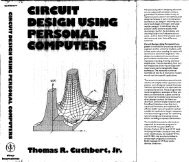Systems Reference Library IBM 1800 System Summary
Systems Reference Library IBM 1800 System Summary
Systems Reference Library IBM 1800 System Summary
You also want an ePaper? Increase the reach of your titles
YUMPU automatically turns print PDFs into web optimized ePapers that Google loves.
available resources of the system. Many parts of<br />
the system are, therefore, often Idle for significant<br />
periods of time. For example, a data conversion<br />
and printing function requires only intermittent use<br />
of the processor-controller and a fraction of the<br />
available storage space and input/output devices.<br />
To increase throughput, the <strong>IBM</strong> <strong>1800</strong> Multiprogramming<br />
Executive Operating <strong>System</strong> enables<br />
programs, core storage space, input/output facilities,<br />
and control of the processor-controller to<br />
be allocated and concurrently shared among several<br />
process functions. These facilities permit multiprogramming;<br />
that is, they permit several process<br />
functions to be performed concurrently and to share<br />
the bastc resources of the computing system. The<br />
MPX operating system helps to ensure that the total<br />
system is kept busy performing productive work as<br />
much of the time as possible.<br />
Thus, :'.IPX efficiently allocates the available<br />
resourceS of the system to morc than one function by<br />
switching control from one function to another as a<br />
delay Is encountered while awaiting an event, such<br />
as the completion of an input/output operation or<br />
the end of a timing Icterval.<br />
Among the services provided by MPX to allow<br />
concurrent operation are:<br />
1. Loading corc loads into available partitions<br />
(core areas) while executing in other areas~<br />
2. Scheduling the use of core loads in all partitions.<br />
3. Switching control of the processor-controller<br />
from one function to another while waiting for<br />
an I/o operation to be completed.<br />
Multiprogramming is regulated on the basis of<br />
I/o operation. When an input/output or timer<br />
operation is initiated in one partilion, tha t area can<br />
be placed in a suspended state until the I/o function<br />
is completed. Concurrently with this, a program<br />
residing in a lower priority partition can be<br />
executed. Since a partition can be assigned to an<br />
interrupt level, the programmed interrupt technique<br />
is used by the system to direct these levels<br />
of operation, thereby controlling the execution of<br />
anyone of 24 possible partitions at any moment<br />
in time. This program interrupt technique,<br />
utilizing the hardware interrupt features of the<br />
<strong>1800</strong>, enables MPX to eliminate time-consuming<br />
list searching operations.<br />
The MPX system provides for unlimited<br />
queueing of I/o operations as well as the ability to<br />
achieve maximum overlap of rio and computing.<br />
In addition, Interrupt programs may he queued and<br />
executed on Interrupt levels within a hierarchy of<br />
priorities chosen by the user. Queueing and 1/0<br />
overlap, as used in the MPX system, provide the <br />
ability to gain full advantage of 15 cycle-stealing <br />
data channels, 24 interrupt levels, and in general, <br />
the pntential of the <strong>IBM</strong> <strong>1800</strong> Data Acquisition and <br />
Control <strong>System</strong>. <br />
:'vIPX COMPONENTS<br />
The <strong>IBM</strong> <strong>1800</strong> Multiprogramming Executive Operating<br />
<strong>System</strong>, like TSX, can be considered, functionally,<br />
to be compnsed of two main compnnents: 1) a coreresident<br />
portion called the system executive and<br />
2) a conventional batch proceSSing monitor. As in<br />
TSX, the system executive is core resident and<br />
controls the loading and execution of the user's<br />
control programs when operating in the real-time<br />
mode. The batch processing monitor operates in<br />
the time-shared mede under control of the system<br />
executive or can function as an independent nonprocess<br />
monitor in the off-line mode. The components<br />
of the batch processing monitor are essentially<br />
the same as described for the 'l'SX nooprocess<br />
monitor. However, some expanded functions have<br />
been added which add new capabilities and provide<br />
eaSe of operation. For example. unlike TSX,<br />
MPX is able to assemble or compile programs<br />
from source files on the disk.<br />
The modularity of MPX, in conjunction with<br />
many system generation options, allows the user to<br />
generate a system to meet the requirements of his<br />
application without being burdened with features in<br />
which he is not interested, The system may be constructed<br />
with up to 24 partitions for multiprogramming<br />
capabilities or may be built as a Single-area,<br />
time-sharing system similar to TSX. It is also<br />
possible to generate a batch processing monitor system<br />
for off-line use.<br />
MPX FEATURES<br />
The following features are available with MPX:<br />
• High throughput.<br />
• Fast response to the process.<br />
• Ease in the scheduling of program execution.<br />
• Ability to modify <strong>IBM</strong> system programs as<br />
well as user programs on-tine.<br />
• On-line diagnostics for critical rio devices,<br />
• Time sharing of multiple foreground (process)<br />
and background (batch processing) operations.<br />
• <strong>System</strong> residence on either 1810 or 2311 disk<br />
drives and full suppnrt for both.<br />
• Sharing of 2311 data files by two <strong>1800</strong>s or an<br />
<strong>1800</strong> and a <strong>System</strong>/l60.<br />
• Up to 32 software timers.<br />
<strong>1800</strong> Programming <strong><strong>System</strong>s</strong> 17

















